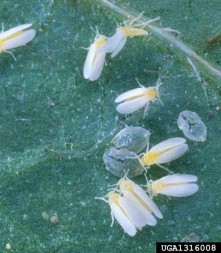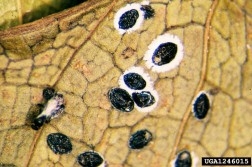Whiteflies
ID
444-280 (ENTO-378NP)
Description
Adult whiteflies are small insects with pale yellow bodies and white wings. Adults measure approximately 2 mm (0.08 inch) long. They superficially resemble tiny moths and large populations on infested plants may take flight when disturbed. Whiteflies actually belong to the order Hemiptera and are close relatives of aphids, scale insects, mealybugs, hoppers and cicadas. Immature whiteflies are often mistaken for scale insects or mealybugs.

Life History
Whiteflies are sap feeders, extracting plant fluids with sucking mouthparts, usually on the underside of leaves. Feeding damage appears as discolored, stunted plant growth and sometimes premature leaf drop. Large populations of whiteflies can produce large volumes of honeydew, which supports the growth of sooty mold, a black fungus. Honeydew accumulation and sooty mold can reduce photosynthesis and crop value. Plant death can occur if large populations of whitefly are left unmanaged. In addition, whiteflies vector numerous plant viruses that damage and kill plants.
Identification
Using the pupal stage to identify whitefly species identification is easier than using the adults. The pupae have a species-specific shape, color pattern, and wax filament arrangement. Adult whiteflies can be identified sometimes by the host association, but identifying whiteflies to species according to the pupal stage is more accurate.
Whitefly in Greenhouses
Whitefly species that infest greenhouse crops can become pests in the landscape when infested greenhouse-grown plants are installed outdoors. Some examples of susceptible greenhouse crops include gerbera daisy, poinsettia, lantana, fuchsia, geraniums (Pelargonium spp.), rue, and belles-of- Ireland. Whitefly species commonly found in greenhouse environments include:
Greenhouse Whitefly Adults hold their wings flat over the abdomen. The pupae are opaque white, oval with elevated vertical sides, and with long waxy threads rising on the top. They have a blocky appearance when viewed from the side and are not flattened like the pupae of silverleaf whitefly. Greenhouse whiteflies primarily infest greenhouse crops, but can also attack ash, dogwood, sycamore, sweetgum, honey locust, black locust, and redbud in the landscape as well.
Silverleaf Whitefly (also known as the sweet potato whitefly Strain B) Adults hold their wings tented over their yellow body (Fig. 1). The pupae are yellow with two red eyespots and are flatter against the surface of the leaf than greenhouse whitefly. The abdominal end of the pupa is more tapered than the head and has several setae. The waxy filaments on silverleaf whitefly pupae are less noticeable than on greenhouse whitefly.
Banded-winged Whitefly Adults have darker markings on the head and thorax and hold their wings roof-like over their bodies. The wings have two or three grayish-brown lines that zigzag across their width. Pupae are oval with raised vertical sides and a light brown medial area. There is a dense marginal fringe of wax of two different lengths as well as long, hooked wax filaments rising from the top of the pupa. Preferred hosts include hibiscus, petunia, geranium (Pelargonium) and poinsettia. This species is usually less common than the two previously mentioned species.
Whitefly in the Landscape
Typically, whitefly infestations are most serious in greenhouse environments, but there are some whitefly species that can be pests in the landscape. Most species that occur in the landscape usually are not major pests, and beneficial insects often keep whitefly populations below damaging levels. However, certain species are more problematic than others.
Azalea Whitefly Primarily an outdoor pest of Rhododendron indicum and other species of azalea with hairy leaves. Populations occasionally become large enough to cause minor leaf yellowing and support the growth of sooty mold. The pupae are yellow and lack fringes. Azalea whitefly only infests azaleas. Rhododendron whiteflies are a different species; the adults appear dusted with white powder.
Mulberry Whitefly Adults look similar to banded- winged whitefly, but also have a vertical bar interrupting the lowest horizontal zigzag at the base of the wing. The pupae are oval, shiny, and all black with a dense fringe of white wax around the edge (Fig. 2). They can infest mulberry, mountain laurel, Norway maple, red maple, boxelder, American holly, Virginia sweet spire, flowering dogwood, and wax myrtle.

Monitoring
Yellow sticky cards are useful for monitoring and trapping adult whiteflies in greenhouses. Sticky cards should be placed near doors and vents to monitor incoming adults from the outdoors. This is especially important in the fall when outside air temperatures begin to cool. Gently tapping plants will disturb the whitefly resting on the leaves, which will allow you to see them as they fly off. Regularly inspect the undersides of leaves for the presence of pupae and adults. Look for yellowing or stunted plants. Counting adults weekly on sticky cards will help you recognize when populations are increasing. Thresholds indicating the need for treatment vary depending on the crop.
Control Options
Suppressing whitefly populations before they grow is essential to prevent plant damage. Whiteflies are difficult to manage once dense populations become established.
Chemical Control: Consult Section 5 on Nursery Crops in the Virginia Pest Management Guide for Horticultural and Forest Crops (VCE-017) for labeled products that can be used to control whitefly populations. Homeowners should see “whiteflies” in the Virginia Pest Management Guide for Home Grounds and Animals (VCE-018). See insecticide labels regarding particular species of whiteflies and follow all recommendations regarding specific crops and insecticide application. Complete coverage, especially the undersides of the leaves where whiteflies feed, is essential for suppression. It is better to use a systemic or a product with a long period of residual activity in environments with dense whitefly populations. Eggs and nonfeeding pupae are less susceptible to insecticides than the feeding immatures and adults. Insecticide resistance is a continuing problem in whitefly populations, so reliance on a single class of insecticides is not recommended.
Alternative Pesticides: When properly applied, horticultural oil works by smothering the whitefly egg and immature stages. Insecticidal soaps are effective against whitefly nymphs. Insect growth regulators (IGR) can be used for suppression of immature populations, but they will not kill adult whiteflies that have completed their development. IGR pesticides must be applied more frequently, especially in situations where adults are abundant and reproducing. These materials can disrupt biological control by previously released beneficial insects in greenhouses and should not be used in conjunction with them.
Biological Control/Beneficial Insects: Suppression of greenhouse whitefly populations with beneficial insects has been very successful when greenhouses are fitted with insect screening over the vents. Insect screening keeps beneficial insects inside and pest insects outside of the greenhouse. Periodic releases of the parasitic wasp Encarsia formosa have suppressed greenhouse whitefly very well for many growers. Eretmocerus californicus is another parasitic wasp known to parasitize sweet potato and greenhouse whitefly, but it has not been as successful as Encarsia. Finally, there is a predatory ladybird beetle, Delphastus pusillus, which is commercially available but used less frequently by growers.
Microbial Insecticides: Microbial insecticides that contain the entomopathogenic fungus Beauvaria bassiana are commercially available for whitefly suppression. These products require a moderate humidity level to assist insect infection, and they must be applied more frequently than conventional insecticides.
Cultural Control: Insect screening can be retrofitted over greenhouses to prevent whiteflies from entering. However, installing screening over greenhouse vents will change the static pressure and ventilation capacity of the greenhouse. Ventilation openings must be adjusted to ensure adequate air circulation and to prevent damage to ventilation equipment. In addition, weeds can harbor whiteflies and should be promptly removed from greenhouse floors and from the outdoor perimeter, especially near vents and doors.
References
Gill, R.J. 1967. Color-photo and Host Keys to California Whiteflies. Scale and Whitefly Key #2. Sacramento: Department of Food and Agriculture, Environmental Monitoring and Pest Management.
Gill, S. and J. Sanderson. 1998. Ball Identification Guide to Greenhouse Pests and Beneficials. Ball Publishing, Batavia, IL. 244 pp.
Johnson, W.T. and H.H. Lyon. 1991. Insects That Feed on Trees and Shrubs. Comstock Publishing, Cornell University Press. Ithaca, NY. 560 pp.
Virginia Cooperative Extension materials are available for public use, reprint, or citation without further permission, provided the use includes credit to the author and to Virginia Cooperative Extension, Virginia Tech, and Virginia State University.
Virginia Cooperative Extension is a partnership of Virginia Tech, Virginia State University, the U.S. Department of Agriculture (USDA), and local governments, and is an equal opportunity employer. For the full non-discrimination statement, please visit ext.vt.edu/accessibility.
Publication Date
May 6, 2020



